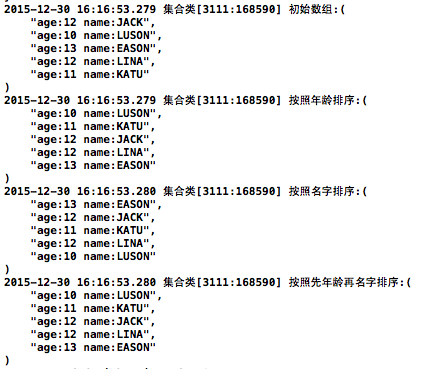Objective-C 排序
2015-12-23 11:33
561 查看
在Objective-C中,排序分为:
1、Foundation框架中的对象排序
2、自定义对象排序
例子:每个学生都有一个成绩score属性,根据成绩score对学生排序
自定义对象 Student.h

Student.m

main.m
结果:

3、自定义对象多个元素排序
JKStudent.h里面:
JKStudent.m里面:

1、Foundation框架中的对象排序
2、自定义对象排序
例子:每个学生都有一个成绩score属性,根据成绩score对学生排序
自定义对象 Student.h

Student.m

main.m
#import <Foundation/Foundation.h>
#import "Student.h"
int main(int argc, const char * argv[]) {
@autoreleasepool {
//1、Foundation框架中的对象排序
NSArray *arr = @[@12, @25, @15, @7, @18];
NSLog(@"排序前: %@", arr);
// 注意: 想使用compare方法对数组中的元素进行排序, 那么数组中的元素必须是Foundation框架中的对象, 也就是说不能是自定义对象
NSArray *newArr = [arr sortedArrayUsingSelector:@selector(compare:)];
NSLog(@"排序后: %@", newArr);
//2、自定义对象排序
Student *stu1 = [Student new];
stu1.score = 91;
Student *stu2 = [Student new];
stu2.score = 97;
Student *stu3 = [Student new];
stu3.score = 95;
Student *stu4 = [Student new];
stu4.score = 87;
NSArray *studentArr = @[stu1, stu2, stu3, stu4];
NSLog(@"排序前: %@", studentArr);
// 按照学生的成绩进行排序
// 不能使用compare:方法对自定义对象进行排序
// NSArray *newArr = [arr sortedArrayUsingSelector:@selector(compare:)];
// 该方法默认会按照升序排序
NSArray *newStudentArr = [studentArr sortedArrayWithOptions:NSSortStable usingComparator:^NSComparisonResult(Student *obj1, Student *obj2) {
//升序
return obj1.score > obj2.score;
//降序
// return obj1.score < obj2.score;
}];
NSLog(@"成绩排序后: %@", newStudentArr);
return 0;
}
return 0;
}结果:

3、自定义对象多个元素排序
JKStudent.h里面:
#import <Foundation/Foundation.h> @interface JKStudent : NSObject @property (nonatomic,assign) int age; @property (nonatomic,retain) NSString *name; -(id)initWithAge:(int)age andName:(NSString*)name; + (JKStudent *) studentWithAge:(int)age andName:(NSString *)name; //排序规则 //比较年龄 -(NSComparisonResult)compare:(JKStudent*)otherStudent; //比较姓名 -(NSComparisonResult)compareName:(JKStudent *)otherStudent; //先年龄后姓名 -(NSComparisonResult)compareAgeAndName:(JKStudent *)otherStudent; @end
JKStudent.m里面:
#import "JKStudent.h"
@implementation JKStudent
-(id)initWithAge:(int)age andName:(NSString*)name{
self = [super init];
if (self) {
self.age = age;
self.name = name;
}
return self;
}
+ (JKStudent *) studentWithAge:(int)age andName:(NSString *)name
{
return [[JKStudent alloc]initWithAge:age andName:name];
}
-(NSString *)description{
return [NSString stringWithFormat:@"age:%d name:%@",self.age,self.name];
}
//排序规则
//比较年龄
-(NSComparisonResult)compare:(JKStudent*)otherStudent{
if(self.age>otherStudent.age){
return NSOrderedDescending;
}else if (self.age == otherStudent.age){
return NSOrderedSame;
}else{
return NSOrderedAscending;
}
}
//比较姓名
-(NSComparisonResult)compareName:(JKStudent *)otherStudent{
return [self.name compare:otherStudent.name];
}
//先年龄后姓名
-(NSComparisonResult)compareAgeAndName:(JKStudent *)otherStudent{
//先比较年龄
if(self.age>otherStudent.age){
return NSOrderedDescending;
}else if (self.age == otherStudent.age){
//比较姓名
return [self.name compare:otherStudent.name];
}else{
return NSOrderedAscending;
}
}//创建5个学生 JKStudent *student1 = [JKStudent studentWithAge:12 andName:@"JACK"]; JKStudent *student2 = [JKStudent studentWithAge:10 andName:@"LUSON"]; JKStudent *student3 = [JKStudent studentWithAge:13 andName:@"EASON"]; JKStudent *student4 = [JKStudent studentWithAge:12 andName:@"LINA"]; JKStudent *student5 = [JKStudent studentWithAge:11 andName:@"KATU"]; //初始数组 NSArray *studentArray1 = [NSArray arrayWithObjects:student1,student2,student3,student4,student5, nil]; NSLog(@"初始数组:%@",studentArray1); //按照年龄排序 NSArray *studentArray2 = [studentArray1 sortedArrayUsingSelector:@selector(compare:)]; NSLog(@"按照年龄排序:%@",studentArray2); //按照名字排序 NSArray *studentArray3 = [studentArray1 sortedArrayUsingSelector:@selector(compareName:)]; NSLog(@"按照名字排序:%@",studentArray3); //按照先年龄再名字排序 NSArray *studentArray4 = [studentArray1 sortedArrayUsingSelector:@selector(compareAgeAndName:)]; NSLog(@"按照先年龄再名字排序:%@",studentArray4);

相关文章推荐
- #Objective - C - sixth-Day OC小练习 省市区排序
- Objective C类方法load和initialize的区别
- [Objective-C]关联(objc_setAssociatedObject、objc_getAssociatedObject、objc_removeAssociatedObjects)
- PHP、JAVA、C#、Object-C、Android 通用的DES加密解密
- Objective-C语法之KVC使用
- Objective-C语法之KVO的使用
- Objective-c语言_KVC
- object自己的方法
- JavaScript object(一)
- objective-c 定位导航
- OBjective-c 地理编码以及反地理编码
- Object-C 一些常用函数
- Objective---C 给tableView添加头视图轮播图
- Objective-C中的属性和实例变量
- Effective Objective-C 2.0 学习笔记---(一)
- pip安装模块警告InsecurePlatformWarning: A true SSLContext object is not available.
- 高效开发iOS系列(runtime篇) -- 巧妙运用对象关联(Associated Objects)来设计alertview
- A Practicable Method for Ferromagnetic Object Moving Direction Identification
- Object类的常见方法
- 【Objective-C学习记录】第二十一天
